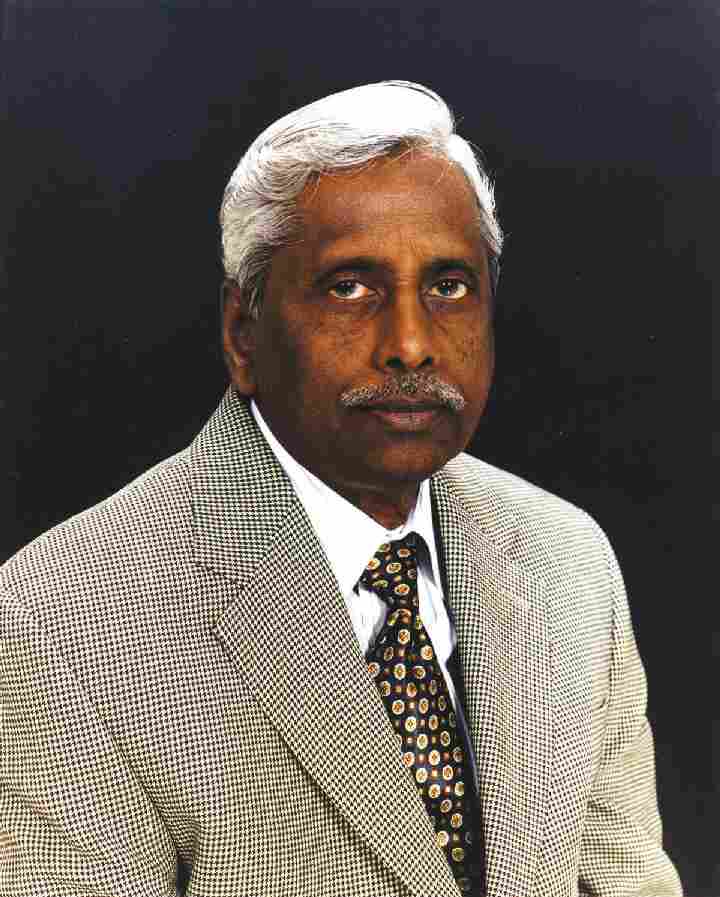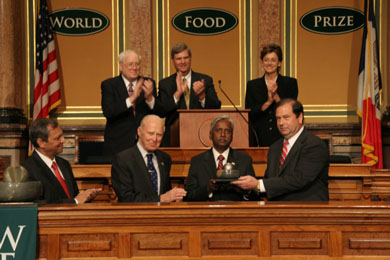The Indian Scientist, Modadugu V. Gupta has been awarded the 2005 World Food Prize for his work to enhance nutrition for over 1 million people through the expansion of aquaculture and fish farming in South and Southeast Asia. Through his “dedicated sustained efforts in Bangladesh, Laos and other countries in Southeast Asiaâ€, Dr. Gupta has been selected as the 2005 World Food laureate for developing small scale aquaculture as a viable means for over one million very poor farmers and women to improve their family’s nutrition and wellbeing’. Dr. Gupta developed unique method of fish farming, requiring little cost while causing no environmental damage. As a result, freshwater fish production has risen dramatically in these countries by as much as three to five times. Dr. Gupta is the sixth citizen of India to receive the prize. . Previous recipients include: Dr. M.S. Swaminathan, 1987; Dr. Verghese Kurien, 1989; Dr. Gurdev Khush, 1996; B.R. Barwale, 1998 and Dr. Surinder K. Vasal, 2000.
Lokvani contacted Dr Gupta via email about his work:
Aquaculture is a unique method of fish farming, requiring little cost while causing no environmental damage. Could you elaborate on how this is done?
While working in Bangladesh I saw opportunities for increasing fish production through bringing hundreds of thousands of seasonal ponds, ditches, roadside canals etc. which retain water for 3-6 months in a year. They were lying fallow covered with water hyacinth and other obnoxious weeds posing health problems as they became breeding grounds for mosquitoes. My enquiries with local people revealed they tried to grow fish but failed as the fish in these shallow, turbid waters could not survive. So, my research looked at types of fish that could survive under those harsh conditions and at the same time has a market value. We found two types of fish which could grow under those conditions and then developed culture practices for those fish. The farmers were able to get 1.5 – 2.5 tons of fish per hectare within 3 to 5 months time. This created lots of interest among farmers and the technology caught up like a wild fire and there is no single ditch/roadside canal without fish.
How did the rural women get motivated?
Then our research concentrated on involving women and landless people. In Bangladesh, at that time rural women were not working in fields and were restricted to managing households. We saw potential for involving these women in aquaculture since the ponds are near to their households and the technology is simple. So we motivated women groups through local NGOs, trained them and the NGOs provided needed micro-credit. This has been very successful and presently 65% of fish farmers in Bangladesh are women. Our subsequent studies showed that women are better farmers than men. We did not end there. Some of the women were intelligent and looking for further opportunities to become entrepreneurs. We trained them as seed (baby fish) producers. This is a seasonal activity lasting about 4 months in year, very profitable, but needs care in handling the fish. The women were once again successful and became entrepreneurs. This resulted in increased incomes to rural households, increased nutrition and most of all has resulted in empowerment of women – with a status in family and the society. In some families women were earning more than their husbands.
How did the landless people get involved in fish production?
In addition to the seasonal ponds/ditches referred to earlier there are over 4 million ponds in Bangladesh which retain water throughout the year (unlike the seasonal ponds mentioned earlier). The fish productions were very low. Technologies were developed for increasing productions from 1 ton per hectare to 5-6 tons per hectare. Out of 4 million ponds, a large number of them are not being used for fish culture as they belong to the state or in case they belong to the private, there were multiple owners who were not willing to invest in fish culture. Here we saw an opportunity to involve landless people. Collaborating with NGOs, these derelict (unused) ponds were leased to the landless groups, they were trained and provided micro-credit by NGOs. This once again proved very successful. This resulted in multiple benefits: increased incomes and nutrition to landless people, increased fish production and availability to consumers and better environment.
You have been involved in aquaculture genetics research? What does this mean to the future?
At present 135 million tons of fish is produced globally of which 35% comes from aquaculture and the rest 65% from capture from the wild (from seas, oceans, rivers, etc.) Of this only 95 million tons is used for human consumption and the rest is used for animal feed. It has been estimated that by year 2020 an additional 40 million tons of food fish will be needed to meet the demand from increasing population, changing dietary habits and improved purchasing power. Since the wild stocks are already exploited at their maximum sustainable levels or in many cases over exploited, there are meager chances of increasing fish production from capture from the wild. Hence, every one is looking to increased production from aquaculture.
What are the best ways to increase production?
Fish production could be increased to certain level through improved culture technologies and better farm management. For increased productions beyond that level what is needed are the breeds of fish that can grow faster. We talk of green revolution – this was possible through improved strains of rice, wheat, corn, soya, etc. This was done through application of genetics which resulted in high yielding, disease/pest resistant strains. Same has happened in the case of poultry and livestock. But in the case of fish, genetic research is nearly 50 years behind. The fish being grown have not been domesticated and due to continuous breeding of the same stock there has been in breeding that has slowed the growth. So, methods were developed for coming up with fast growing species of fish – for example GIFT tilapia – a strain developed through selective breeding grows to double the size in the same time period as compared to before its genetic improvement. The methodology is being used for a number of other species of fish in Asia and Africa. Since aquaculture genetics is a new subject, we formed the International Network on Genetics in Aquaculture (INGA) in which 13 countries from Asia, Pacific and Africa and 14 advanced scientific institutions and international organizations are members. I was coordinating this research network, and through the network we undertook human resources development in developing country institutions, organized regional research programs, assisted in exchange of improved breeds of fish among countries and at policy level.
Lokvani Congratulates Dr Gupta on his achievement and contirbutions to the World community

